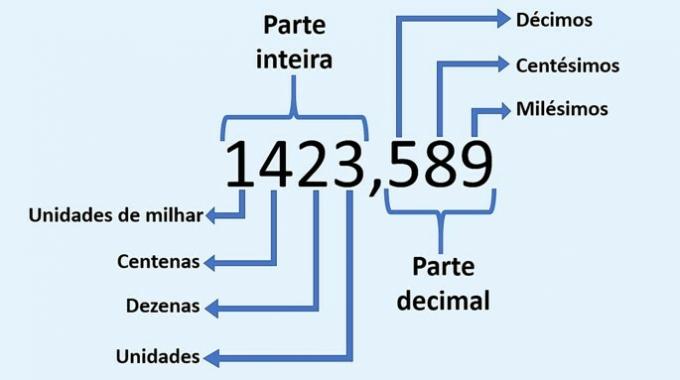The decimal numbering system is based on 10, that is, it uses 10 different digits (symbols) to represent all the numbers.
Formed by the digits 0, 1, 2, 3, 4, 5, 6, 7, 8, 9, it is a positional system, that is, the position of the digit in the number modifies its value.
It's the numbering system we use. It was conceived by the Hindus and disseminated in the West by the Arabs, hence it is also called the "Indo-Arabic numbering system".

Evolution of the decimal numbering system
Features
- It has different symbols to represent quantities from 1 to 9 and a symbol to represent the absence of quantity (zero).
- As it is a positional system, even though it has few symbols, it is possible to represent all numbers.
- The quantities are grouped from 10 to 10, and receive the following names:
10 units = 1 ten
10 tens = 1 hundred
10 hundreds = 1 unit of thousands, and so on
Examples

Orders and Classes
In the decimal numbering system, each digit represents an order, starting from right to left and every three orders we have a class.

To read very large numbers, we divide the digits of the number into classes (blocks of 3 orders), putting a dot to separate the classes, starting from right to left.
Examples
1) 57283
First, we separate the 3-digit blocks from right to left and place a dot to separate the number: 57. 283.
In the table above we see that 57 belongs to the thousands class and 283 to the simple units class. So the number will read as: fifty-seven thousand, two hundred and eighty-three.
2) 12839696
Separating the 3-digit blocks we have: 12,839,696
The number will then read as: twelve million, eight hundred and thirty-nine thousand, six hundred and ninety-six.
To learn more, read also:
- Natural Numbers
- Integers
- Decimal numbers
- Rational Numbers
- real numbers
Solved Exercises
1) Consider the number 643018 and answer:
a) What is the name of the class that belongs to the number 4?
b) Which digit occupies the order of ten?
c) How many units is the digit 3 worth?
a) thousands class
b) 1
c) 3,000 units
2) The Brazilian Institute of Geography and Statistics (IBGE) estimates that Brazil will have, in 2017, 207,700,000 inhabitants. Write this value out in full.
Two hundred and seven million and seven hundred thousand inhabitants.
3) Given the number 137459072, indicate:
a) How many units represent the number 7 that is to the left of 4?
b) How many units represent the digit 7 that is to the left of the 2?
a) 7,000,000 units
b) 70 units
See too: operations with decimal numbers


